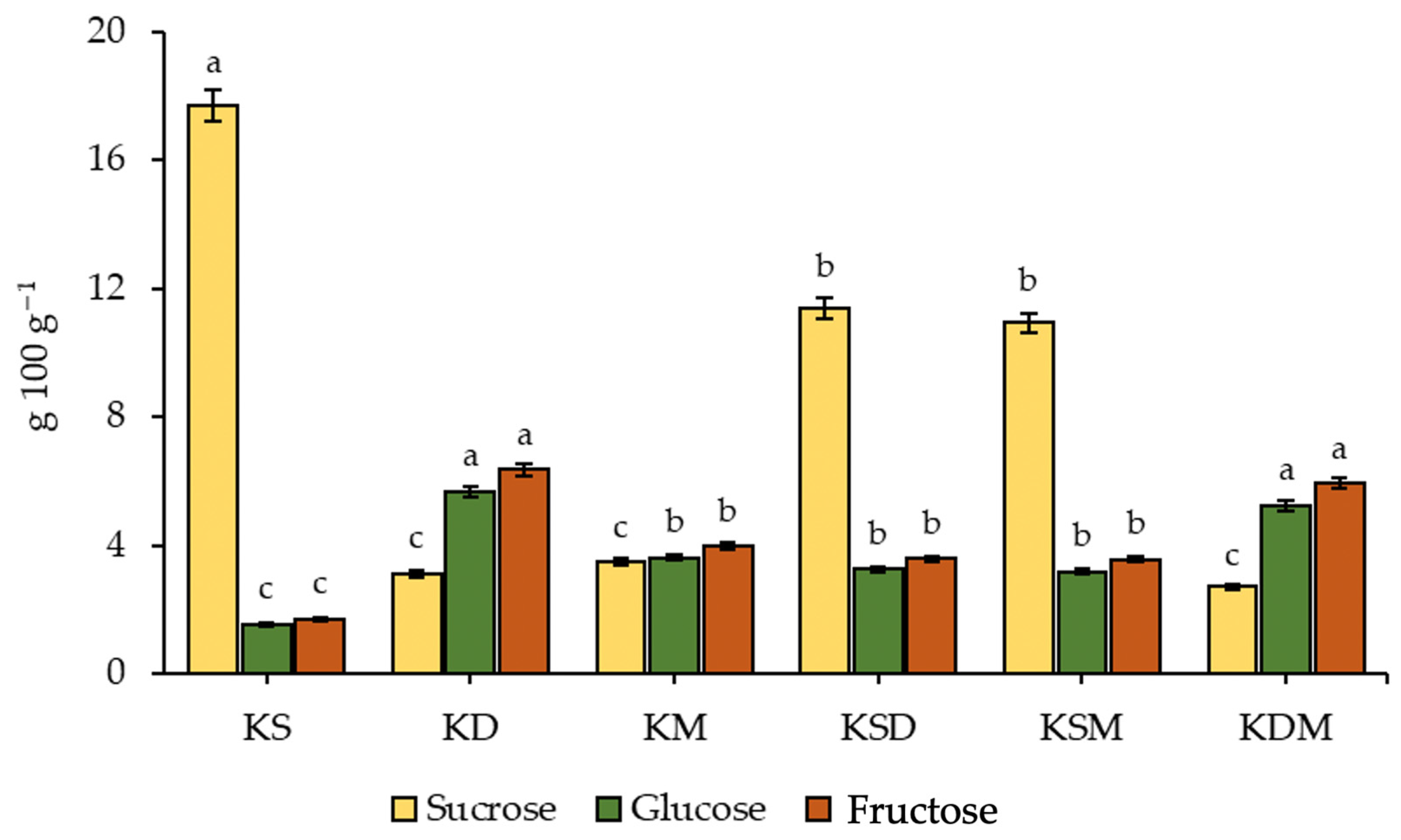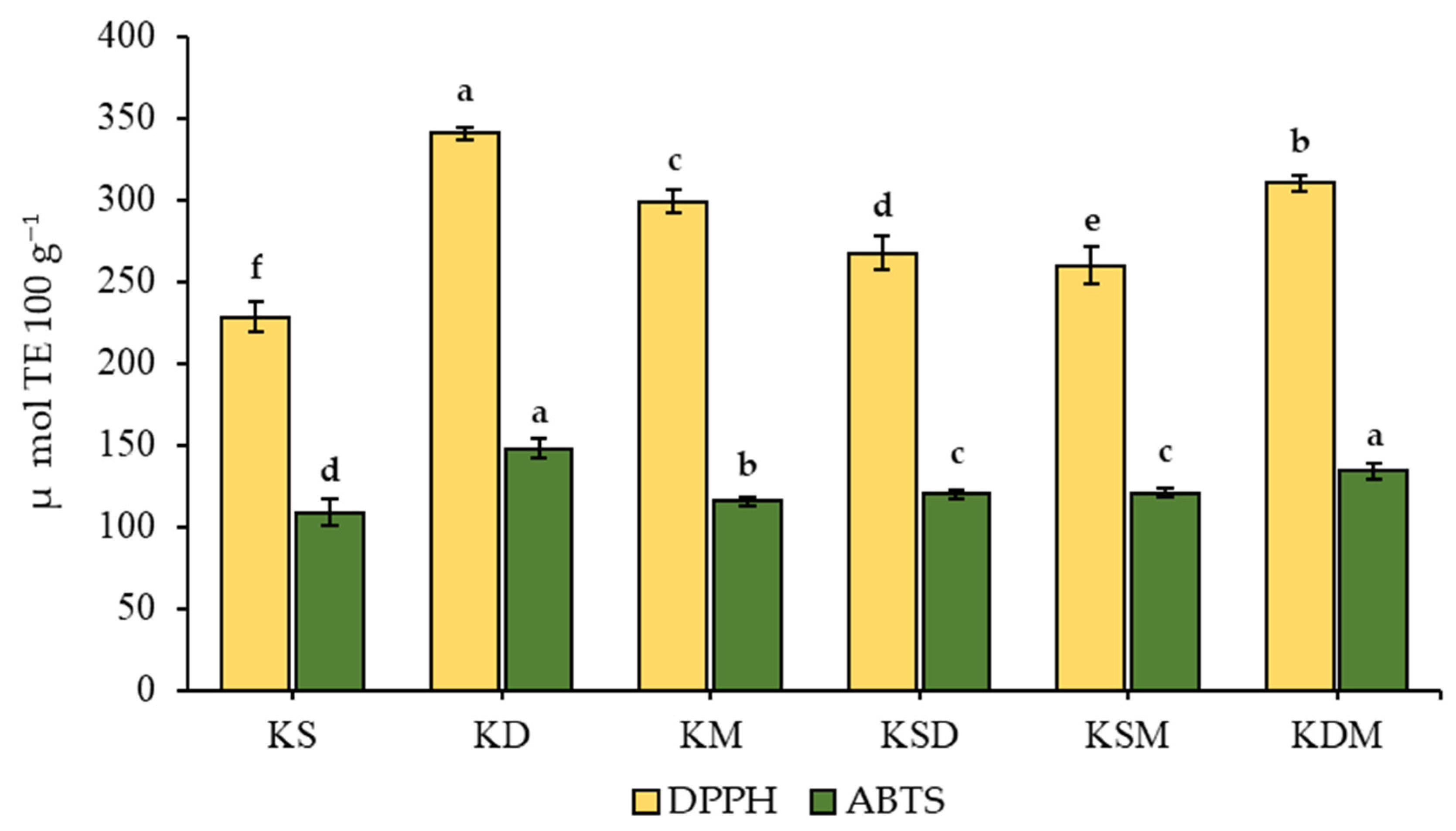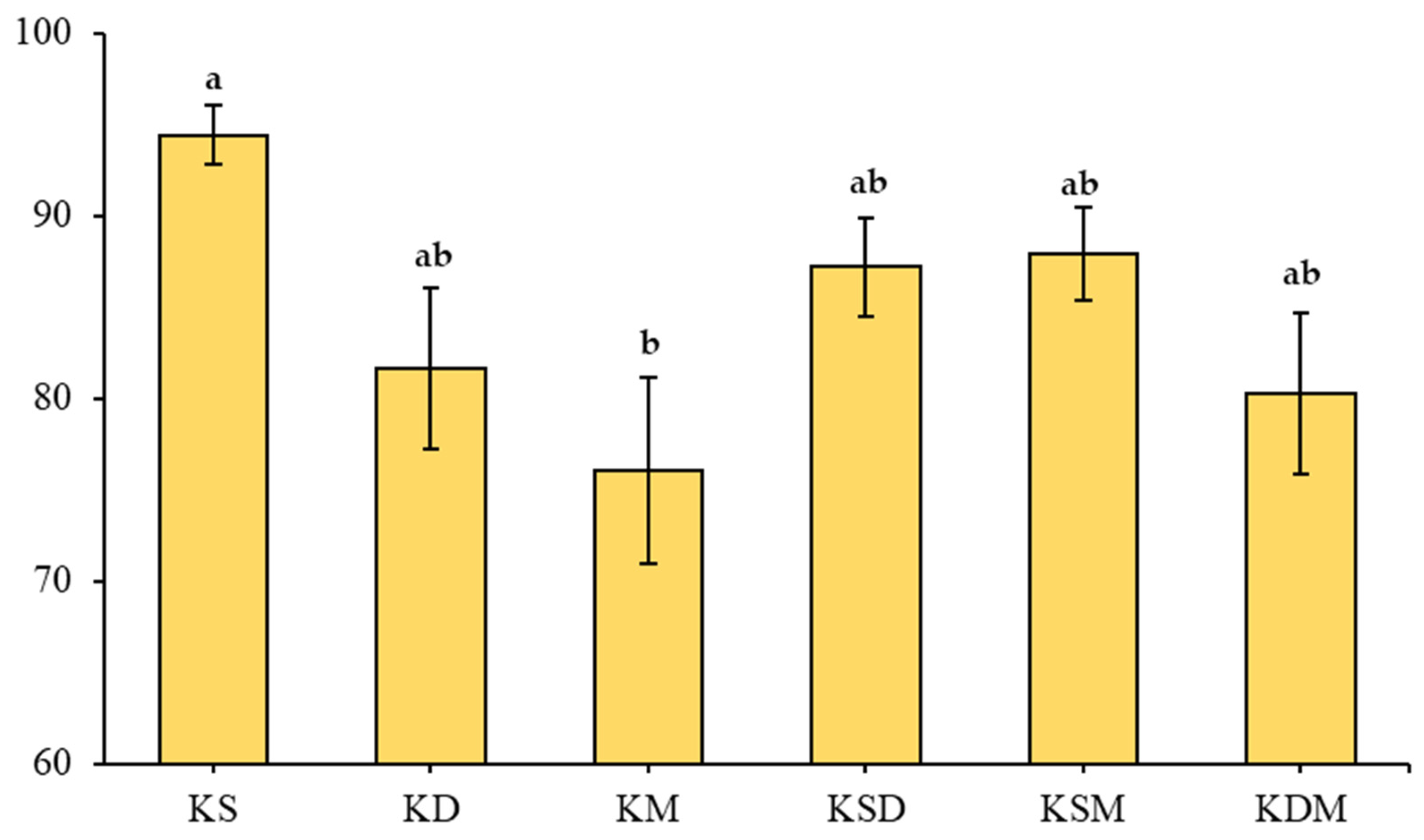The Effect of Sugar Replacement with Different Proportions of Khalas Date Powder and Molasses on the Nutritional and Sensory Properties of Kleicha
Abstract
1. Introduction
2. Materials and Methods
2.1. Ingredients
2.2. Formulation of Different Fillings of Kleicha
2.3. Manufacturing of Kleicha
2.4. Proximate Chemical Composition and Minerals of Kleicha
2.5. Phytochemicals Analysis of Kleicha
2.6. Antioxidant Capacity Determination
2.7. Sugar Profile by HPLC
2.8. In Vitro Glycemic Index of Kleicha
2.9. Sensory Evaluation of Kleicha
2.10. Statistical Analysis
3. Results
3.1. Proximate Composition of Kleicha
3.2. Minerals Content in Kleicha
3.3. Sugar Profile by HPLC
3.4. In Vitro Glycemic Index
3.5. Phytochemicals Analysis of Kleicha
| Treatment * | Phytochemicals Analysis | |||
|---|---|---|---|---|
| TPC mg GAE 100 g−1 | TF mg QE 100 g−1 | TFL mg QE 100 g−1 | Carotenoids mg 100 g−1 | |
| KS | 701.16 ± 29.92 d | 228.28 ± 9.24 e | 108.68 ± 8.16 c | 334.46 ± 26.64 c |
| KD | 1498.66 ± 22.52 a | 340.67 ± 3.92 a | 148.05 ± 6.15 a | 425.66 ± 8.77 a |
| KM | 1252.07 ± 33.27 b | 299.19 ± 7.45 bc | 115.67 ± 3.04 bc | 365.31 ± 11.92 bc |
| KSD | 1076.2 ± 32.20 c | 267.74 ± 10.13 cd | 120.01 ± 2.70 bc | 359.24 ± 11.62 bc |
| KSM | 971.63 ± 21.16 c | 259.99 ± 11.18 de | 120.94 ± 2.60 bc | 366.56 ± 7.05 bc |
| KDM | 1398.5 ± 39.71 a | 310.45 ± 4.64 ab | 134.18 ± 4.96 ab | 405.75 ± 5.35 ab |
3.6. Antioxidant Capacity Determination
3.7. Sensory Evaluation
4. Discussion
5. Conclusions
Author Contributions
Funding
Data Availability Statement
Acknowledgments
Conflicts of Interest
References
- Barakat, H.; Alfheeaid, H.A. Date Palm Fruit (Phoenix dactylifera) and Its Promising Potential in Developing Functional Energy Bars: Review of Chemical, Nutritional, Functional, and Sensory Attributes. Nutrients 2023, 15, 2134. [Google Scholar] [CrossRef] [PubMed]
- Nadeem, M.; Qureshi, T.M.; Ugulu, I.; Riaz, M.N.; An, Q.; Khan, Z.I.; Ahmad, K.; Ashfaq, A.; Bashir, H.; Dogan, Y. Mineral, Vitamin and Phenolic Contents and Sugar Profiles of Some Prominent Date Palm (Phoenix dactylifera) Varieties of Pakistan. Pak. J. Bot. 2019, 51, 171–178. [Google Scholar] [CrossRef] [PubMed]
- Elleuch, M.; Besbes, S.; Roiseux, O.; Blecker, C.; Deroanne, C.; Drira, N.-E.; Attia, H. Date Flesh: Chemical Composition and Characteristics of the Dietary Fibre. Food Chem. 2008, 111, 676–682. [Google Scholar] [CrossRef]
- Ibrahim, S.A.; Ayad, A.A.; Williams, L.L.; Ayivi, R.D.; Gyawali, R.; Krastanov, A.; Aljaloud, S.O. Date Fruit: A Review of the Chemical and Nutritional Compounds, Functional Effects and Food Application in Nutrition Bars for Athletes. Int. J. Food Sci. 2021, 56, 1503–1513. [Google Scholar] [CrossRef]
- Siddeeg, A.; Zeng, X.-A.; Ammar, A.-F.; Han, Z. Sugar Profile, Volatile Compounds, Composition and Antioxidant Activity of Sukkari Date Palm Fruit. J. Food Sci. Technol. 2019, 56, 754–762. [Google Scholar] [CrossRef] [PubMed]
- Echegaray, N.; Pateiro, M.; Gullon, B.; Amarowicz, R.; Misihairabgwi, J.M.; Lorenzo, J.M. Phoenix dactylifera Products in Human Health—A Review. Trends Food Sci. Technol. 2020, 105, 238–250. [Google Scholar] [CrossRef]
- Siddiq, M.; Greiby, I. Overview of Date Fruit Production, Postharvest Handling, Processing, and Nutrition. In Dates: Postharvest Science, Processing Technology and Health Benefits; John Wiley & Sons: Hoboken, NJ, USA, 2013; pp. 1–28. [Google Scholar]
- Hussain, M.I.; Farooq, M.; Syed, Q.A. Nutritional and Biological Characteristics of the Date Palm Fruit (Phoenix dactylifera L.)—A Review. Food Biosci. 2020, 34, 100509. [Google Scholar] [CrossRef]
- United States Department of Agriculture (USDA). 2020. Available online: https://fdc.nal.usda.gov/fdc-app.html (accessed on 22 May 2023).
- Amadou, I. Date Fruits: Nutritional Composition of Dates (Balanites Aegyptiaca Delile and Phoenix dactylifera L.). In Nutritional Composition of Fruit Cultivars; Elsevier: Amsterdam, The Netherlands, 2016; pp. 215–233. [Google Scholar]
- Aljutaily, T.; Barakat, H.; Moustafa, M.M.; Rehan, M. Incorporation of Sukkari Date in Probiotic-Enriched Fermented Camel Milk Improves the Nutritional, Physicochemical, and Organoleptical Characteristics. Fermentation 2021, 8, 5. [Google Scholar] [CrossRef]
- Assirey, E.A.R. Nutritional Composition of Fruit of 10 Date Palm (Phoenix dactylifera L.) Cultivars Grown in Saudi Arabia. J. Taibah Univ. Sci. 2015, 9, 75–79. [Google Scholar] [CrossRef]
- Ayad, A.A.; Williams, L.L.; Gad El-Rab, D.A.; Ayivi, R.; Colleran, H.L.; Aljaloud, S.; Ibrahim, S.A. A Review of the Chemical Composition, Nutritional and Health Benefits of Dates for Their Potential Use in Energy Nutrition Bars for Athletes. Cogent Food Agric. 2020, 6, 1809309. [Google Scholar] [CrossRef]
- Hamad, I.; AbdElgawad, H.; Al Jaouni, S.; Zinta, G.; Asard, H.; Hassan, S.; Hegab, M.; Hagagy, N.; Selim, S. Metabolic Analysis of Various Date Palm Fruit (Phoenix dactylifera L.) Cultivars from Saudi Arabia to Assess Their Nutritional Quality. Molecules 2015, 20, 13620–13641. [Google Scholar] [CrossRef] [PubMed]
- Ralston, R.; Lee, J.; Truby, H.; Palermo, C.; Walker, K. A Systematic Review and Meta-Analysis of Elevated Blood Pressure and Consumption of Dairy Foods. J. Hum. Hypertens. 2012, 26, 3–13. [Google Scholar] [CrossRef] [PubMed]
- Eid, N.M.; Al-Awadi, B.; Vauzour, D.; Oruna-Concha, M.J.; Spencer, J.P. Effect of Cultivar Type and Ripening on the Polyphenol Content of Date Palm Fruit. J. Agric. Food Chem. 2013, 61, 2453–2460. [Google Scholar] [PubMed]
- Razali, N.S.M.; Wenyin, B.; Arjunan, R.D.; Hashim, H.; Abdullah, A. Total Phenolic Content and Antioxidant Activities of Date Fruit Extracts. Malays. Appl. Biol. 2019, 48, 103–108. [Google Scholar]
- Alfheeaid, H.A.; Barakat, H.; Althwab, S.A.; Musa, K.H.; Malkova, D. Nutritional and Physicochemical Characteristics of Innovative High Energy and Protein Fruit- and Date-Based Bars. Foods 2023, 12, 2777. [Google Scholar] [CrossRef]
- Al-Farsi, M.A.; Lee, C.Y. Nutritional and Functional Properties of Dates: A Review. Crit. Rev. Food Sci. Nutr. 2008, 48, 877–887. [Google Scholar] [CrossRef] [PubMed]
- Al-Farsi, M.; Alasalvar, C.; Morris, A.; Baron, M.; Shahidi, F. Comparison of Antioxidant Activity, Anthocyanins, Carotenoids, and Phenolics of Three Native Fresh and Sun-Dried Date (Phoenix dactylifera L.) Varieties Grown in Oman. J. Agric. Food Chem. 2005, 53, 7592–7599. [Google Scholar] [CrossRef] [PubMed]
- Nadeem, M.; Qureshi, T.M.; Ahmad, M.M.; Riaz, M.N.; Ameer, A. Development of Free Flowing Date Powder and Its Utilization in Muffins to Enhance Nutritional Value. J. Agric. Res. 2017, 55, 03681157. [Google Scholar]
- Abd El-Hady, E.S.A.; Alfheeaid, H.A.; Abd El-Razik, M.M.; Althwab, S.A.; Barakat, H. Nutritional, Physicochemical, and Organoleptic Properties of Camel Meat Burger Incorporating Unpollinated Barhi Date Fruit Pulp. Int. J. Food Sci. 2022, 2022, 4581821. [Google Scholar] [CrossRef]
- Vayalil, P.K. Date Fruits (Phoenix dactylifera L.): An Emerging Medicinal Food. Crit. Rev. Food Sci. Nutr. 2012, 52, 249–271. [Google Scholar] [CrossRef]
- Al-Dashti, Y.A.; Holt, R.R.; Keen, C.L.; Hackman, R.M. Date Palm Fruit (Phoenix dactylifera): Effects on Vascular Health and Future Research Directions. Int. J. Mol. Sci. 2021, 22, 4665. [Google Scholar] [CrossRef]
- Ali, Z.; Li, J.; Zhang, Y.; Naeem, N.; Younas, S.; Javeed, F. Dates (Phoenix dactylifera) and Date Vinegar: Preventive Role against Various Diseases and Related in Vivo Mechanisms. Food Rev. Int. 2022, 38, 480–507. [Google Scholar] [CrossRef]
- Al-Mudhaffar, A.W. Dates and Sugar Technology; Aldar Al-Jameaeh for Printing, Publishing and Translation; University of Kufa Iraq: Kufa, Iraq, 2019; p. 450. [Google Scholar]
- A.O.A.C. Official Methods of Analysis of the Association of Official Analytical Chemists; Association of Official Analytical Chemists: Washington, DC, USA, 2000. [Google Scholar]
- Borah, S.; Baruah, A.M.; Das, A.K.; Borah, J. Determination of Mineral Content in Commonly Consumed Leafy Vegetables. Food Anal. Methods 2009, 2, 226–230. [Google Scholar] [CrossRef]
- Nsimba, R.Y.; Kikuzaki, H.; Konishi, Y. Antioxidant Activity of Various Extracts and Fractions of Chenopodium Quinoa and Amaranthus Spp. Seeds. Food Chem. 2008, 106, 760–766. [Google Scholar] [CrossRef]
- Mohdaly, A.A.A.; Hassanien, M.F.R.; Mahmoud, A.; Sarhan, M.A.; Smetanska, I. Phenolics Extracted from Potato, Sugar Beet, and Sesame Processing by-Products. Int. J. Food Prop. 2013, 16, 1148–1168. [Google Scholar] [CrossRef]
- Kumaran, A.; Karunakaran, R.J. In Vitro Antioxidant Activities of Methanol Extracts of Five Phyllanthus Species from India. LWT Food Sci. Technol. 2007, 40, 344–352. [Google Scholar] [CrossRef]
- Yuan, G.-f.; Sun, B.; Yuan, J.; Wang, Q.-m. Effects of Different Cooking Methods on Health-Promoting Compounds of Broccoli. J. Zhejiang Univ. Sci. B 2009, 10, 580–588. [Google Scholar] [CrossRef] [PubMed]
- Khalifa, I.; Barakat, H.; El-Mansy, H.A.; Soliman, S.A. Optimizing Bioactive Substances Extraction Procedures from Guava, Olive and Potato Processing Wastes and Evaluating Their Antioxidant Capacity. J. Food Chem. Nanotechnol. 2016, 2, 170–177. [Google Scholar] [CrossRef]
- Lu, J.; Zhao, H.; Chen, J.; Fan, W.; Dong, J.; Kong, W.; Sun, J.; Cao, Y.; Cai, G. Evolution of Phenolic Compounds and Antioxidant Activity During Malting. J. Agric. Food Chem. 2007, 55, 10994–11001. [Google Scholar] [CrossRef]
- Association of Official Analytical Chemists. Aoac Official Method 982.14.: Glucose, Fructose, Sucrose, and Maltose in Presweetened Cereals—Liquid Chromatographic Method; Association of Official Analytical Chemists: Washington, DC, USA, 2007. [Google Scholar]
- Englyst, H.N.; Veenstra, J.; Hudson, G.J. Measurement of Rapidly Available Glucose (Rag) in Plant Foods: A Potential In Vitro Predictor of the Glycaemic Response. Br. J. Nutr. 1996, 75, 327–337. [Google Scholar] [CrossRef]
- Goñi, I.; Garcia-Alonso, A.; Saura-Calixto, F. A Starch Hydrolysis Procedure to Estimate Glycemic Index. Nutr. Res. 1997, 17, 427–437. [Google Scholar] [CrossRef]
- Peter Ikechukwu, A.; Okafor, D.; Kabuo, N.; Ibeabuchi, J.; Odimegwu, E.; Alagbaoso, S.; Njideka, N.; Mbah, R. Production and Evaluation of Cookies from Whole Wheat and Date Palm Fruit Pulp as Sugar Substitute. Int. J. Eng. Technol. Manag. Appl. Sci. 2017, 4, 1–31. [Google Scholar]
- Steel, R.G. Pinciples and Procedures of Statistics a Biometrical Approach, 3rd ed.; McGraw-Hill: Boston, MA, USA, 1997. [Google Scholar]
- Aleid, S.M.; Haddadin, J.S. Valorization and Chemical Constituents Assessments of Khalas Dates Fruit, Syrup and Pits. Curr. Res. Nutr. Food Sci. 2023, 11, 77–87. [Google Scholar] [CrossRef]
- El-Sharnouby, G.A.; Aleid, S.M.; Al-Otaibi, M.M. Nutritional Quality of Biscuit Supplemented with Wheat Bran and Date Palm Fruits (Phoenix dactylifera L.). Food Nutr. Sci. 2012, 3, 322–328. [Google Scholar]
- Ahmed, J.; Al-Jasass, F.M.; Siddiq, M. Date Fruit Composition and Nutrition. In Dates; John Wiley & Sons: Hoboken, NJ, USA, 2013; pp. 261–283. [Google Scholar]
- Al-Saikhan, M.S.; Sallam, A. Impact of Chemical and Non-Chemical Thinning Treatments on Yield and Fruit Quality of Date Palm. J. Food Res. 2015, 4, 18–29. [Google Scholar] [CrossRef][Green Version]
- Brand-Miller, J.C. Glycemic Load and Chronic Disease. Nutr. Rev. 2003, 61, S49–S55. [Google Scholar] [CrossRef] [PubMed]
- Sameen, A.; Manzoor, M.F.; Khan, M.I.; Sahar, A.; Saddique, A. Quality Evaluation of Ice Cream Prepared with Phoenix dactylifera Syrup as a Substitute of Sugar. Pak. J. Food Sci. 2016, 26, 226–233. [Google Scholar]
- Julai, K.; Sridonpai, P.; Ngampeerapong, C.; Tongdonpo, K.; Suttisansanee, U.; Kriengsinyos, W.; On-Nom, N.; Tangsuphoom, N. Effects of Extraction and Evaporation Methods on Physico-Chemical, Functional, and Nutritional Properties of Syrups from Barhi Dates (Phoenix dactylifera L.). Foods 2023, 12, 1268. [Google Scholar] [CrossRef]
- Jarrar, A.H.; Kamal-Eldin, A.; Bataineh, M.a.; Al Dhaheri, A.S. Glycemic Index (Gi) and Glycemic Load (Gl) Values for Dried Bisr and Tamr Dates. Emir. J. Food Agric. 2019, 31, 88–94. [Google Scholar] [CrossRef]
- Liu, S.; Manson, J.E.; Stampfer, M.J.; Holmes, M.D.; Hu, F.B.; Hankinson, S.E.; Willett, W.C. Dietary Glycemic Load Assessed by Food-Frequency Questionnaire in Relation to Plasma High-Density-Lipoprotein Cholesterol and Fasting Plasma Triacylglycerols in Postmenopausal Women. Am. J. Clin. Nutr. 2001, 73, 560–566. [Google Scholar] [CrossRef]
- Mohamed, S.A.; Awad, M.A.; El-Dengawy, E.-R.F.; Abdel-Mageed, H.M.; El-Badry, M.O.; Salah, H.A.; Abdel-Aty, A.M.; Fahmy, A.S. Total Phenolic and Flavonoid Contents and Antioxidant Activities of Sixteen Commercial Date Cultivars Grown in Saudi Arabia. RSC Adv. 2016, 6, 44814–44819. [Google Scholar] [CrossRef]
- Manickavasagan, A.; Mathew, T.; Al-Attabi, Z.; Al-Zakwani, I. Dates as a Substitute for Added Sugar in Traditional Foods? A Case Study with Idli. Emir. J. Food Agric. 2013, 25, 899–906. [Google Scholar] [CrossRef]
- Al-Farsi, M.A.; Lee, C.Y. 25 the Functional Values of Dates. In Dates: Production, Processing, Food, and Medicinal Values; CRC Press: Boca Raton, FL, USA, 2012; p. 351. [Google Scholar]



| Treatment * | Chemical Composition g 100 g−1 fw | |||||
|---|---|---|---|---|---|---|
| Moisture | Ash | Curd Fat | Crude Protein | Dietary Fiber | Available Carbohydrates | |
| KS | 8.23 ± 0.02 e | 1.15 ± 0.01 c | 17.66 ± 0.08 b | 15.25 ± 0.23 ab | 4.97 ± 0.12 bc | 57.72 ± 0.28 a |
| KD | 9.95 ± 0.14 d | 1.45 ± 0.01 a | 18.24 ± 0.14 a | 15.65 ± 0.15 a | 6.22 ± 0.14 a | 54.72 ± 0.31 b |
| KM | 14.18 ± 0.25 a | 1.45 ± 0.01 a | 18.27 ± 0.08 a | 14.76 ± 0.23 b | 4.87 ± 0.11 c | 51.36 ± 0.12 d |
| KSD | 9.51 ± 0.11 d | 1.3 ± 0.02 b | 18.65 ± 0.07 a | 15.24 ± 0.15 ab | 6.07 ± 0.14 a | 55.30 ± 0.20 b |
| KSM | 11.02 ± 0.06 c | 1.17 ± 0.01 c | 18.66 ± 0.12 a | 15.59 ± 0.11 a | 5.47 ± 0.13 b | 53.56 ± 0.16 c |
| KDM | 11.6325 ± 0.08 b | 1.32 ± 0.03 b | 18.43 ± 0.20 a | 15.33 ± 0.16 ab | 6.09 ± 0.14 a | 53.29 ± 0.32 c |
| Treatments * | Minerals Content mg 100 g−1 | ||||||||
|---|---|---|---|---|---|---|---|---|---|
| K | Na | Ca | P | Mg | Fe | Mn | Cu | Zn | |
| KS | 1151.33 ± 7.77 d | 905.04 ± 23.45 b | 163.92 ± 3.27 c | 25.61 ± 0.48 bc | 402.87 ± 4.75 c | 9.83 ± 0.22 bc | 8.88 ± 0.27 c | 98.26 ± 0.77 c | 34.31 ± 0.68 b |
| KD | 1578.37 ± 30.31 b | 948.85 ± 8.33 b | 190.08 ± 4.19 ab | 24.01 ± 0.41 c | 450.81 ± 2.64 a | 12.94 ± 0.9 a | 10.29 ± 0.08 a | 67.91 ± 2.19 e | 33.55 ± 1.12 b |
| KM | 1598.37 ± 25.89 b | 1014.82 ± 20.95 b | 177.42 ± 5.93 bc | 25.29 ± 1.14 bc | 450.58 ± 8.68 a | 12.37 ± 0.12 a | 10.16 ± 0.1 a | 131.97 ± 1.31 a | 54.85 ± 0.76 a |
| KSD | 1450.42 ± 12.27 c | 963.88 ± 20.87 ab | 182.43 ± 4.28 bc | 26.06 ± 0.48 abc | 415.64 ± 6.34 bc | 11.49 ± 0.31 ab | 10.04 ± 0.2 ab | 114.87 ± 0.92 b | 51.14 ± 2.76 a |
| KSM | 1463.58 ± 2.21 c | 1024.86 ± 15.59 ab | 187.59 ± 7.45 ab | 27.6 ± 0.33 ab | 421 ± 4.55 bc | 9.45 ± 0.26 c | 9.49 ± 0.06 bc | 75.22 ± 2.08 d | 36.56 ± 3.52 b |
| KDM | 1696.44 ± 6.38 a | 1136.06 ± 83.3 a | 209.24 ± 5.85 a | 28.78 ± 1.01 a | 433.47 ± 3.08 ab | 10.24 ± 0.22 bc | 9.85 ± 0.1 ab | 42.67 ± 1.68 f | 21.42 ± 2.4 c |
| Treatment * | Glycemic Index | Glycemic Load |
|---|---|---|
| KS | 40.21 ± 0.01 bc | 21.21 ± 0.01 a |
| KD | 40.18 ± 0.01 cd | 19.49 ± 0.02 c |
| KM | 40.30 ± 0.01 a | 18.73 ± 0.01 f |
| KSD | 40.19 ± 0.01 bc | 19.78 ± 0.01 b |
| KSM | 40.21 ± 0.02 b | 19.34 ± 0.03 d |
| KDM | 40.15 ± 0.02 d | 18.95 ± 0.01 e |
Disclaimer/Publisher’s Note: The statements, opinions and data contained in all publications are solely those of the individual author(s) and contributor(s) and not of MDPI and/or the editor(s). MDPI and/or the editor(s) disclaim responsibility for any injury to people or property resulting from any ideas, methods, instructions or products referred to in the content. |
© 2023 by the authors. Licensee MDPI, Basel, Switzerland. This article is an open access article distributed under the terms and conditions of the Creative Commons Attribution (CC BY) license (https://creativecommons.org/licenses/by/4.0/).
Share and Cite
Almuziree, R.S.A.; Alhomaid, R.M. The Effect of Sugar Replacement with Different Proportions of Khalas Date Powder and Molasses on the Nutritional and Sensory Properties of Kleicha. Processes 2023, 11, 3077. https://doi.org/10.3390/pr11113077
Almuziree RSA, Alhomaid RM. The Effect of Sugar Replacement with Different Proportions of Khalas Date Powder and Molasses on the Nutritional and Sensory Properties of Kleicha. Processes. 2023; 11(11):3077. https://doi.org/10.3390/pr11113077
Chicago/Turabian StyleAlmuziree, Raya S. A., and Raghad M. Alhomaid. 2023. "The Effect of Sugar Replacement with Different Proportions of Khalas Date Powder and Molasses on the Nutritional and Sensory Properties of Kleicha" Processes 11, no. 11: 3077. https://doi.org/10.3390/pr11113077
APA StyleAlmuziree, R. S. A., & Alhomaid, R. M. (2023). The Effect of Sugar Replacement with Different Proportions of Khalas Date Powder and Molasses on the Nutritional and Sensory Properties of Kleicha. Processes, 11(11), 3077. https://doi.org/10.3390/pr11113077










